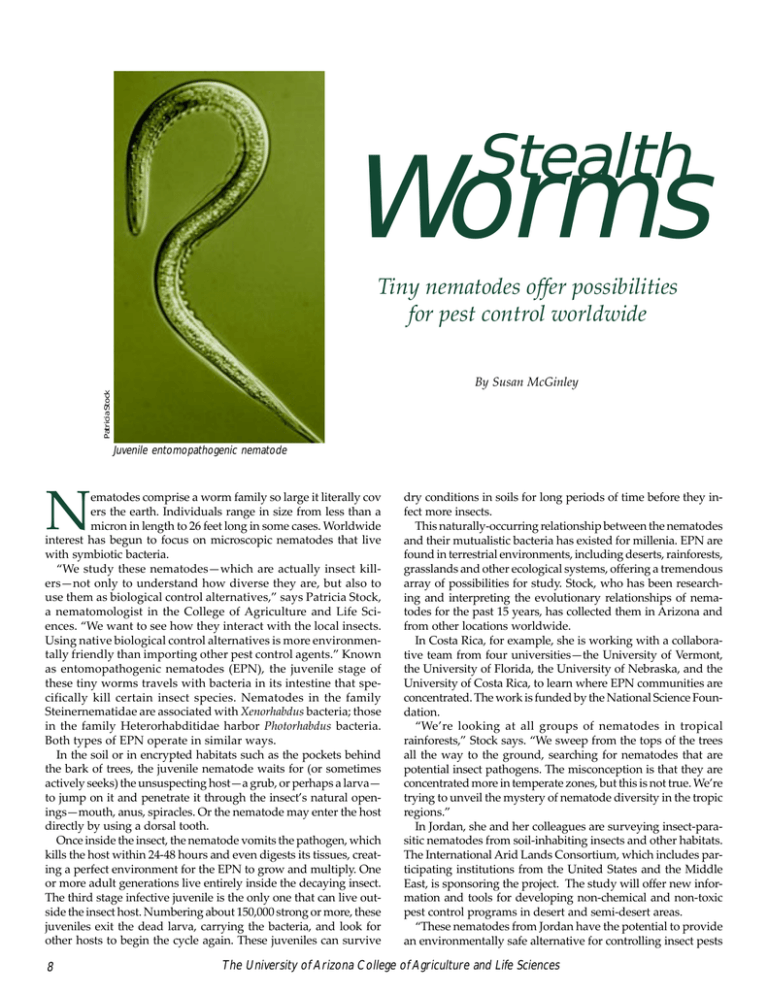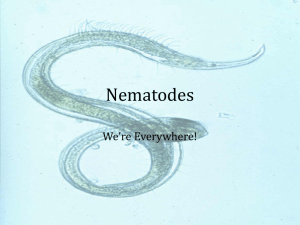Worms Stealth N Tiny nematodes offer possibilities
advertisement

Stealth Worms Tiny nematodes offer possibilities for pest control worldwide Patricia Stock By Susan McGinley Juvenile entomopathogenic nematode N ematodes comprise a worm family so large it literally cov ers the earth. Individuals range in size from less than a micron in length to 26 feet long in some cases. Worldwide interest has begun to focus on microscopic nematodes that live with symbiotic bacteria. “We study these nematodes—which are actually insect killers—not only to understand how diverse they are, but also to use them as biological control alternatives,” says Patricia Stock, a nematomologist in the College of Agriculture and Life Sciences. “We want to see how they interact with the local insects. Using native biological control alternatives is more environmentally friendly than importing other pest control agents.” Known as entomopathogenic nematodes (EPN), the juvenile stage of these tiny worms travels with bacteria in its intestine that specifically kill certain insect species. Nematodes in the family Steinernematidae are associated with Xenorhabdus bacteria; those in the family Heterorhabditidae harbor Photorhabdus bacteria. Both types of EPN operate in similar ways. In the soil or in encrypted habitats such as the pockets behind the bark of trees, the juvenile nematode waits for (or sometimes actively seeks) the unsuspecting host—a grub, or perhaps a larva— to jump on it and penetrate it through the insect’s natural openings—mouth, anus, spiracles. Or the nematode may enter the host directly by using a dorsal tooth. Once inside the insect, the nematode vomits the pathogen, which kills the host within 24-48 hours and even digests its tissues, creating a perfect environment for the EPN to grow and multiply. One or more adult generations live entirely inside the decaying insect. The third stage infective juvenile is the only one that can live outside the insect host. Numbering about 150,000 strong or more, these juveniles exit the dead larva, carrying the bacteria, and look for other hosts to begin the cycle again. These juveniles can survive 8 dry conditions in soils for long periods of time before they infect more insects. This naturally-occurring relationship between the nematodes and their mutualistic bacteria has existed for millenia. EPN are found in terrestrial environments, including deserts, rainforests, grasslands and other ecological systems, offering a tremendous array of possibilities for study. Stock, who has been researching and interpreting the evolutionary relationships of nematodes for the past 15 years, has collected them in Arizona and from other locations worldwide. In Costa Rica, for example, she is working with a collaborative team from four universities—the University of Vermont, the University of Florida, the University of Nebraska, and the University of Costa Rica, to learn where EPN communities are concentrated. The work is funded by the National Science Foundation. “We’re looking at all groups of nematodes in tropical rainforests,” Stock says. “We sweep from the tops of the trees all the way to the ground, searching for nematodes that are potential insect pathogens. The misconception is that they are concentrated more in temperate zones, but this is not true. We’re trying to unveil the mystery of nematode diversity in the tropic regions.” In Jordan, she and her colleagues are surveying insect-parasitic nematodes from soil-inhabiting insects and other habitats. The International Arid Lands Consortium, which includes participating institutions from the United States and the Middle East, is sponsoring the project. The study will offer new information and tools for developing non-chemical and non-toxic pest control programs in desert and semi-desert areas. “These nematodes from Jordan have the potential to provide an environmentally safe alternative for controlling insect pests The University of Arizona College of Agriculture and Life Sciences Entomopathogenic Nematodes: A Mutualistic Relationship Patricia Stock Taken from “entomo”(insect) and “pathogen” (disease-causing), an entomopathogenic nematode (EPN) kills certain insects indirectly by introducing bacteria into them. These include lepidopteran insects (caterpillars), coleopteran insects (weevils, white grubs), orthopteran insects (crickets, molecrickets), among many others, and even other nematodes that are plantparasites. The bacteria kill the insect through septicemia, allowing the nematode to grow and multiply in the decaying body. Both the nematode and the symbiotic bacteria need each other to survive. Microscopic entomopathogenic nematodes measure just microns in length. in agricultural and forestry systems, and also for controlling insect pests of human and veterinary importance,“ Stock says. In each location the scientists start with biotic surveys to find out which nematodes and their corresponding bacteria meet local pest management goals. Then they gather samples from soil or other habitats for testing in the laboratory. The nematodes are accurately identified and analyzed using traditional morphology (structure and function) techniques and through molecular screening, including PCR (polymerase chain reaction) and DNA sequence analysis. The researchers determine the nematode’s temperature and moisture requirements, the insect hosts it colonizes, and other characteristics. Lists of EPN evolutionary associations, called phylogenies, are assembled to show how the nematodes have evolved in relation to each other and how they are related in a geographic region to affect similar hosts. “We always look at the insect and nematode interactions in the laboratory first, then go out and look at the crops and environment,” Stock says. Some of her work involves comparing commercially available formulations of nematodes with custom-made applications of local nematodes. In Arizona, Stock’s team is collecting native species of EPN for pest control trials in citrus and iceberg lettuce, with funding from the Arizona Citrus Research Council and the Arizona Iceberg Lettuce Research Council. Ninety percent of the citrus orchards in the state have the parasitic citrus nematode. “We’re looking for options in pest control,” Stock says. “We’re using the entomopathogenic nematodes to antagonize the citrus nematode and other plant-parasitic nematodes and disrupt their life cycle and their infection into the citrus roots.” This study is using commercially available nematode products along with isolates of nematodes collected from Arizona’s sky island (mountain) regions. For the lettuce trials, native nematodes gathered from the soil in Yuma will be used. “It’s better to use native rather than exotic nematodes to preserve biodiversity,” Stock says. It’s possible that similar species of nematodes can be used singly or together in reducing pest insect populations. Once the right nematodes are identified, they can be suspended in a gelatinous matrix, or dried in powder, then mixed in water and sprayed, broadcast or irrigated onto crops. Large numbers of infectious juveniles are released to inundate and kill the pest insects quickly. Depending on climate conditions, this method works best on greenhouse ornamentals and vegetables, citrus, cranberry, turfgrass and other crops, rather than on high-acreage crops like cotton and soybeans. “The beauty of this is that in the last 20 years nematodes have been formulated and commercialized,” Stock says. “They are more expensive than a chemical product, but so far they have been demonstrated not to harm humans, livestock, beneficial insects or the environment. Nematodes usually have to be underground—their targets are soil insects.” The formulations keep improving as newer isolates of nematodes are found, The nematode is dependent upon the bacterium for: _ Quickly killing its insect host _ Creating a suitable environment for its development by producing antibiotics that suppress competing microorganisms _ Transforming the host tissues into a food source _ Serving as a food resource The bacterium needs the nematode for: _ Protection from the external environment _ Penetration into the host’s body _ Inhibition of the host’s antibacterial proteins and there is a lot of commercial interest in matching nematodes to pests, according to Stock. “Yet these nematodes are so powerful and pathogenic not in and of themselves, but because they live in symbiosis with bacteria,” Stock concludes. “Both the bacteria and the nematode need each other to survive, making them not only good as biological agents, but also as model systems for understanding basic questions in biology.”Given the number of nematodes that exist in the world, the possibilities for discovery are immense. “The whole nematode phylum is estimated to have 500,000 to a million species,” Stock says. “About 25,000 species have been identified so far.” CONTACT Patricia Stock (520) 626-3854 spstock@ag.arizona.edu cals.arizona.edu/PLP/faculty/stock.html 2004 Agricultural Experiment Station Research Report 9







